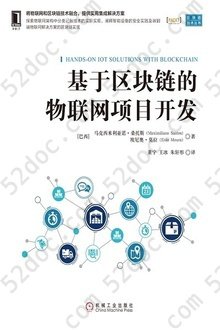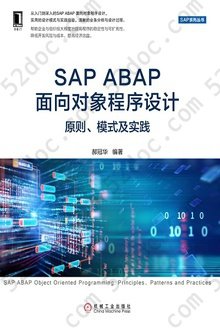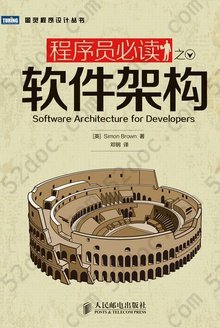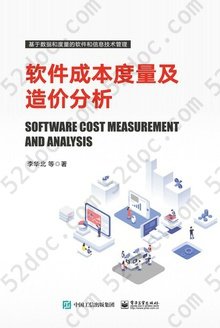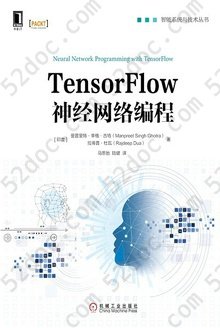注重体验与质量的电子书资源下载网站
分类于: 互联网 设计
简介
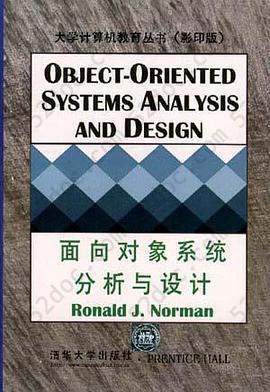
面向对象系统分析与设计 豆 0.0分
资源最后更新于 2020-08-26 18:00:38
作者:诺曼
出版社:清华大学出版社
出版日期:1998-01
ISBN:9787302029441
文件格式: pdf
简介· · · · · ·
内容简介
本书为三大部分:I介绍系统分析与设计,进而讨论
系统的开发过程,包括可行性分析,需求确定活动,面向对
象方法学及面向对象模型;II讨论物理设计及其实现,包
括输出设计,输入设计,文件与数据库设计,软件的构造及
测试概念,最后涉及技术与组织行为的关系;Ⅲ.各种相辅相
成的专题介绍,这些专题起着对前两部分内容的补充作用,
或可作为系统分析和设计的工具,其内容都很重要。
本书强调实用性,是作者多年教学经验的总结,尽量少
用学生难于接受的慨念及理论,而以丰富的实践经验材料来
充实内容,因而更适用作大学生学习信息系统开发或软件工
程的教材,也可作研究生学习的参考资料。
目录
Contents in Brief
PREFACE
Part I Systems Analysis and Conceptual Design
1. INTRODUCTION
2. FEASIBILITY ANALYSIS AND REOUIREMENrS DETERMINATION
3. AN OBJECr-ORIENTED METHODOLOGY AND MODEL
4. OBJECTS AND CLASSES
5. OBJECT RESPONSIBILITIES ATTRIBUTES
6. OBJECT RESPONSIBILITIES: CLASS AND OBJECT CONNECTIONS
7. OBJECT RESPONSIBILITIES SERVICES AND SCENARIOS
Part II Physical Design & Implementation
8. SYSTEMS DESIGN
9. OUTPUTDESIGN
10 INPUTDESIGN
11. FILE AND DATABASE DESIGN
12. SOFTWARE CONSTRUCTION AND TESTING
13 IMPLEMENTATION
Part III Modules-Miscellaneous Systems Analysis and Design Topics
A. INFORMATION SYSTEMS PLANNING
B. PROTOTYPING
C. COMPUTER-AIDED SOFTWARE ENGINEERING (CASE)
D. SOFTWARE PROCESS IMPROVEMENT
E. THE SYSTEMS DEVELOPMENT CHALLENGE
F. PROJECT MANAGEMENT
G. COMMUNICATION AND ELECTRONIC MEETINGS
H. BUSINESS PROCESS REENGINEERING
GLOSSARY
RECOMMENDED READING TO GET STARTED-AUGUST 1995
BIBLIOGRAPHY-OBJECr-ORIENTEDTECHNOLOGY
INDEX
PREFACE
Part I Systems Analysis and Conceptual Design
1. INTRODUCTION
Chcapter Objectives
Systems Analysis and Design Has Many Other Names
What is a System?
What is an Infonnation System?
What is an Automated Information System?
What are the Basic Characteristics ofan Infonnation System?
What is Systems Analysis and Design?
What Makes Systems Analysis and Design such a Difficult Human
Endeavor?
Stakeholders ofan Information System
Systems Analysis and Design as a Career
What does a Systems Analyst Do?
What is a Systems Analyst Responsible For?
Systems Analysis and Design Skills and Activities
General Model of Systems Analysis and Design
The Detailed Activities ofAnalysis and Design
Systems Analysis and Design Projects
Where do Information Systems Analysis and Design Projects Come
From?
Information Systems Requirements Specification
Information Systems Life Cycle and Information Systems Develop-
ment Life Cycle (SDLC)
Principles to Guide Information Systems Analysis and Design
Summary
Questions
References
2.FEASIBILITY ANALYSIS AND REQUIREMENTS DETERMINATION
Chapter Objectives
Feasibility Analysis
Feasibility Types,
Requirements Determination
Problem Domain
Frameworks for Unoersianaing and Doing Requirements
Determination
Reqirements Determittation Sub-Activities,The Pieces Frame-
Work, Kozar's Requirements Model,Object-Oriented
Requirements Determination ModelingActivities,
Methods Used to Gather an Information System's Requirements
Feedback to the User
Requirements Ambiguity
Summary
Questions
References
3.AN OBJECT-ORIENTED METHODOLOGY AND MODEL
Chapter Objectives
Methodologies
The Traditional Methodology
Structured Analysis and Design
Methodology
Information Modeling Methodology
Object-Oriented Methodology
Key Characteristics ofan
Object-Oriented Methodology
Two Classic Problems Resolved with Object-Oriented Analysis and
Design
Classification Theory
Coad's Object-Oriented Methodology
Contents
Coad's Object-Oriented Analysis and Design Methodology and
Notation
Coad 's Object Model Components
An Object-Oriented Model
Summary
Questions
References
4. OBJECrS AND CLASSES
Chapter Objectives
Objects and Classes
Object and Class Rules and Guidelines
Class Attributes and
Services Defined
Comment on Object-Oriented Problem Solving
Stmtegy
Finding Objects
Wirfs-Brock Noun Phrase Strategy
Wirfs-Brock CRC Strategy
Conglomeration Strategy
The Video Slore Example - Finding
Objects
A Future Enhancements Strategy
Summary
Questions
References
5. OBJECT RESPONSIBILITIES: ATTRIBUTES
Chapter Objectives
Attributes
Determining Attributes,Attribute Types,Object-
OrientedMethodologyStrategyforDiffersntAttributeTvDes
Object-Oriented Slrategyfor Multivalue Attribules,The Video
Store Example - Identifying Attributes
Summary
Questions
References
6. OBJECT RESPONSIBILITIES: CLASS AND OBJECT
CONNECTIONS
Chapter Objectives
"Who T Know" Responsibility ofan Object
Object Pattems
Generalization-Specialization Pattem,Generalization-
Specialization Inheritance,Whole-Part Objecl Connection
Pattem,Heuristics jor Finding Whole-Parl Patlems
Object Connection Patterns
Video Store Example
Summary
Questions
References
7. OBJECT RESPONSIBILITIES: SERVICES AND SCENARIOS
Chapter Objectives
"What 1 Do" Responsibility ofan Object
Business Objeclives & Tactics
Information Systems Objectives and
Tactics. and Policies and Procedures
Types ofServices
Basic Services
Problem Domain Specific Services
Finding and Identifying Services
The Video Store Example -Identifying Services
Other Techniques for Identifying Services
Service Details
Techniquesfor Documenting and Describing Service Details
Scenarios
Structured English or Pseudocode
Decision
Tables and Decision Trees
A Decision Table Example
Decision Tree Example
State-Transition Diagrams
TheVideo Store Example - Assigning Services to Classes and Message Con-nections
Transition from Systems Analysis to Systems Design
Summary
Questions
References
Part II Physical Design & Implementation
8. SYSTEMS DESIGN
Chapter Objectives
Information Systems Design
Historical Information Systems Design
An Objecl-Oriented
Analysis and Design Methodology
Information Systems Design
Strategy Choices
Object-Oriented Design
Altemative Object-Oriented Information Systems Development
Strategies
Summary
Questions
References
9. OUTPUTDESIGN
Chapter Objectives
Output: High Quality, Usable Infonnation
Output Types
Jntemat, Extemal and Turnaround Outputs
Static and Dynamic
Outputs
Output Devices and Media
Output Formats
Output: Report Types
Output: Graphs
Output: Internal Controls
The Future ofOutput Desigii
Summary
Questions
References
10. INPUT DESIGN
Chapter Objectives
Introduction
The Many Facets oflnput Data
Data Validation and Verification
Input Data Methods
Input Devices
General Guidelines for Inputing Data
Graphical User Interface (GUI) Design for Input
Summary
Questions
References
11. FILE AND DATABASE OESKSN
Chapter Objectives
Files and Databases
Data Structures
Attribute Classifications
File Types
File Access and Organization
Normalization
Object-Oriented Database
Evolution of Object-Oriented
Database
Charcteristics ofan Object-Oviented Data Model
Strengths ofan Object-Oriented Dalabase
Weaknessesofan Object-Orienled Database
Summary
Questions
References
12. SOFTWARE CONSTRUCTION AND TESTING
Chapter Objectives
Introduction
General Software Design Principles
Software Construction Framework
Object-Oriented Software Construction Framework
Software Constmction Strategies
Cohesion and Coupling
Object-Oriented Cohesion and Coupling
Software Testing
Software Testing Stmlegies,A Generic Sqftware Testing Method-
ology
Application and Code Generators
Summary
Questions
References
13. IMPLEMENTATION
Chapter Objectives
Introduction
Install: The First Phase oflmplementation
Activate: The Second Phase oflmplementation
Institutionalization.The Final Phase oflmplementation
Organizational (Planned) Change for Information Systems
The Slages of Organizational Change,
Action Research and Force Field Analysis
Implementation Critical Success Factors
Summary
Questions
References
Part III Modulea-Miscellaneous Systems Analysis and Design Topics
A INFORMATION SYSTEMS PLANNING
Module Objectives
Introduction
A Generic Infonnation Systems Planning Methodology
Why Engage in Infonnation Systems Planning?
Information Systems Planning Techniques and Methodologies
Summary
Questions
References
B. PROTOTYPING
Module Objectives
Prototyping's Placement within a Systems Development Life
Cycle
Product versus Information Systems Prototyping Differences
Prototyping Benefits
Prototyping's Risk
Prototyping Synonyms
Enabling Technologies for Prototyping
Does Prototyping Work?
How to Initiate Prototyping
Summary
Questions
References
C. COMPUTER-AIDED SOFTWARE ENGINEERING (CASE)
Module Objectives
Introduction
CASE Architecture
The Stages ofCASE Usage
TheBenefitsofCASE
The Issues ofCASE
Summary
Questions
References
D. SOFTWARE PROCESS IMPROVEMENT
Module Objectives
Introduction
Immature and Mature Systems Development Organizations
The Five Maturity Levels ofthe SEI Capability Maturity Model
A Generic Systems Development Process Improvement Model
The ISO 9000 Process Improvement Methodology
Summary
Questions
References
E.THE SYSTEMS DEVELOPMENT CHALLENGE
Module Objectives
Introduction
Software Development's Quadruple Constraint
Information Technology Management Issues
Systems Development Risks
Systems Analysis and Design versus Software Engineering
A Systems Development Architecture for the 1990S
SDLC, Methodology, Technique, and Tool
Summary
Questions
References
F.PROJECT MANAGEMENT
Module Objectives
Introduction
Two Tools: PERT Network and Gantt Chart
The PERT Network, A PERT Network Example, PERT
Network Strengths and Weaknesses, The Gantt Chart,
A Gantl Chart Example,
Summary
Questions
References
G.COMMUNICATION AND ELECTRONIC MEETINGS
Module Objectives
Communication within an Information Systems Development
Project
Systems Development Project Communication Opportunities
Problem Solving Session Strategy
Electronic Meetings to Support Group Work
Summary
Questions
References
H.BUSINESS PROCESS REENGINEERING
Module Objectives
Introduction
Lessons Leamed from Organizations that Have Done It
The Core ofBusiness Process Reengineering
Business Process Reengineering is Organizational Change
A Business Process Reengineering Strategy
Summary
Questions
References
GLOSSARY
RECOMMENDED READING TO GET STARTED-AUGUST 1995
BIBUOGRAPHY-OBJECT-ORIENTED TECHNOLOGY
INDEX
PREFACE
Part I Systems Analysis and Conceptual Design
1. INTRODUCTION
2. FEASIBILITY ANALYSIS AND REOUIREMENrS DETERMINATION
3. AN OBJECr-ORIENTED METHODOLOGY AND MODEL
4. OBJECTS AND CLASSES
5. OBJECT RESPONSIBILITIES ATTRIBUTES
6. OBJECT RESPONSIBILITIES: CLASS AND OBJECT CONNECTIONS
7. OBJECT RESPONSIBILITIES SERVICES AND SCENARIOS
Part II Physical Design & Implementation
8. SYSTEMS DESIGN
9. OUTPUTDESIGN
10 INPUTDESIGN
11. FILE AND DATABASE DESIGN
12. SOFTWARE CONSTRUCTION AND TESTING
13 IMPLEMENTATION
Part III Modules-Miscellaneous Systems Analysis and Design Topics
A. INFORMATION SYSTEMS PLANNING
B. PROTOTYPING
C. COMPUTER-AIDED SOFTWARE ENGINEERING (CASE)
D. SOFTWARE PROCESS IMPROVEMENT
E. THE SYSTEMS DEVELOPMENT CHALLENGE
F. PROJECT MANAGEMENT
G. COMMUNICATION AND ELECTRONIC MEETINGS
H. BUSINESS PROCESS REENGINEERING
GLOSSARY
RECOMMENDED READING TO GET STARTED-AUGUST 1995
BIBLIOGRAPHY-OBJECr-ORIENTEDTECHNOLOGY
INDEX
PREFACE
Part I Systems Analysis and Conceptual Design
1. INTRODUCTION
Chcapter Objectives
Systems Analysis and Design Has Many Other Names
What is a System?
What is an Infonnation System?
What is an Automated Information System?
What are the Basic Characteristics ofan Infonnation System?
What is Systems Analysis and Design?
What Makes Systems Analysis and Design such a Difficult Human
Endeavor?
Stakeholders ofan Information System
Systems Analysis and Design as a Career
What does a Systems Analyst Do?
What is a Systems Analyst Responsible For?
Systems Analysis and Design Skills and Activities
General Model of Systems Analysis and Design
The Detailed Activities ofAnalysis and Design
Systems Analysis and Design Projects
Where do Information Systems Analysis and Design Projects Come
From?
Information Systems Requirements Specification
Information Systems Life Cycle and Information Systems Develop-
ment Life Cycle (SDLC)
Principles to Guide Information Systems Analysis and Design
Summary
Questions
References
2.FEASIBILITY ANALYSIS AND REQUIREMENTS DETERMINATION
Chapter Objectives
Feasibility Analysis
Feasibility Types,
Requirements Determination
Problem Domain
Frameworks for Unoersianaing and Doing Requirements
Determination
Reqirements Determittation Sub-Activities,The Pieces Frame-
Work, Kozar's Requirements Model,Object-Oriented
Requirements Determination ModelingActivities,
Methods Used to Gather an Information System's Requirements
Feedback to the User
Requirements Ambiguity
Summary
Questions
References
3.AN OBJECT-ORIENTED METHODOLOGY AND MODEL
Chapter Objectives
Methodologies
The Traditional Methodology
Structured Analysis and Design
Methodology
Information Modeling Methodology
Object-Oriented Methodology
Key Characteristics ofan
Object-Oriented Methodology
Two Classic Problems Resolved with Object-Oriented Analysis and
Design
Classification Theory
Coad's Object-Oriented Methodology
Contents
Coad's Object-Oriented Analysis and Design Methodology and
Notation
Coad 's Object Model Components
An Object-Oriented Model
Summary
Questions
References
4. OBJECrS AND CLASSES
Chapter Objectives
Objects and Classes
Object and Class Rules and Guidelines
Class Attributes and
Services Defined
Comment on Object-Oriented Problem Solving
Stmtegy
Finding Objects
Wirfs-Brock Noun Phrase Strategy
Wirfs-Brock CRC Strategy
Conglomeration Strategy
The Video Slore Example - Finding
Objects
A Future Enhancements Strategy
Summary
Questions
References
5. OBJECT RESPONSIBILITIES: ATTRIBUTES
Chapter Objectives
Attributes
Determining Attributes,Attribute Types,Object-
OrientedMethodologyStrategyforDiffersntAttributeTvDes
Object-Oriented Slrategyfor Multivalue Attribules,The Video
Store Example - Identifying Attributes
Summary
Questions
References
6. OBJECT RESPONSIBILITIES: CLASS AND OBJECT
CONNECTIONS
Chapter Objectives
"Who T Know" Responsibility ofan Object
Object Pattems
Generalization-Specialization Pattem,Generalization-
Specialization Inheritance,Whole-Part Objecl Connection
Pattem,Heuristics jor Finding Whole-Parl Patlems
Object Connection Patterns
Video Store Example
Summary
Questions
References
7. OBJECT RESPONSIBILITIES: SERVICES AND SCENARIOS
Chapter Objectives
"What 1 Do" Responsibility ofan Object
Business Objeclives & Tactics
Information Systems Objectives and
Tactics. and Policies and Procedures
Types ofServices
Basic Services
Problem Domain Specific Services
Finding and Identifying Services
The Video Store Example -Identifying Services
Other Techniques for Identifying Services
Service Details
Techniquesfor Documenting and Describing Service Details
Scenarios
Structured English or Pseudocode
Decision
Tables and Decision Trees
A Decision Table Example
Decision Tree Example
State-Transition Diagrams
TheVideo Store Example - Assigning Services to Classes and Message Con-nections
Transition from Systems Analysis to Systems Design
Summary
Questions
References
Part II Physical Design & Implementation
8. SYSTEMS DESIGN
Chapter Objectives
Information Systems Design
Historical Information Systems Design
An Objecl-Oriented
Analysis and Design Methodology
Information Systems Design
Strategy Choices
Object-Oriented Design
Altemative Object-Oriented Information Systems Development
Strategies
Summary
Questions
References
9. OUTPUTDESIGN
Chapter Objectives
Output: High Quality, Usable Infonnation
Output Types
Jntemat, Extemal and Turnaround Outputs
Static and Dynamic
Outputs
Output Devices and Media
Output Formats
Output: Report Types
Output: Graphs
Output: Internal Controls
The Future ofOutput Desigii
Summary
Questions
References
10. INPUT DESIGN
Chapter Objectives
Introduction
The Many Facets oflnput Data
Data Validation and Verification
Input Data Methods
Input Devices
General Guidelines for Inputing Data
Graphical User Interface (GUI) Design for Input
Summary
Questions
References
11. FILE AND DATABASE OESKSN
Chapter Objectives
Files and Databases
Data Structures
Attribute Classifications
File Types
File Access and Organization
Normalization
Object-Oriented Database
Evolution of Object-Oriented
Database
Charcteristics ofan Object-Oviented Data Model
Strengths ofan Object-Oriented Dalabase
Weaknessesofan Object-Orienled Database
Summary
Questions
References
12. SOFTWARE CONSTRUCTION AND TESTING
Chapter Objectives
Introduction
General Software Design Principles
Software Construction Framework
Object-Oriented Software Construction Framework
Software Constmction Strategies
Cohesion and Coupling
Object-Oriented Cohesion and Coupling
Software Testing
Software Testing Stmlegies,A Generic Sqftware Testing Method-
ology
Application and Code Generators
Summary
Questions
References
13. IMPLEMENTATION
Chapter Objectives
Introduction
Install: The First Phase oflmplementation
Activate: The Second Phase oflmplementation
Institutionalization.The Final Phase oflmplementation
Organizational (Planned) Change for Information Systems
The Slages of Organizational Change,
Action Research and Force Field Analysis
Implementation Critical Success Factors
Summary
Questions
References
Part III Modulea-Miscellaneous Systems Analysis and Design Topics
A INFORMATION SYSTEMS PLANNING
Module Objectives
Introduction
A Generic Infonnation Systems Planning Methodology
Why Engage in Infonnation Systems Planning?
Information Systems Planning Techniques and Methodologies
Summary
Questions
References
B. PROTOTYPING
Module Objectives
Prototyping's Placement within a Systems Development Life
Cycle
Product versus Information Systems Prototyping Differences
Prototyping Benefits
Prototyping's Risk
Prototyping Synonyms
Enabling Technologies for Prototyping
Does Prototyping Work?
How to Initiate Prototyping
Summary
Questions
References
C. COMPUTER-AIDED SOFTWARE ENGINEERING (CASE)
Module Objectives
Introduction
CASE Architecture
The Stages ofCASE Usage
TheBenefitsofCASE
The Issues ofCASE
Summary
Questions
References
D. SOFTWARE PROCESS IMPROVEMENT
Module Objectives
Introduction
Immature and Mature Systems Development Organizations
The Five Maturity Levels ofthe SEI Capability Maturity Model
A Generic Systems Development Process Improvement Model
The ISO 9000 Process Improvement Methodology
Summary
Questions
References
E.THE SYSTEMS DEVELOPMENT CHALLENGE
Module Objectives
Introduction
Software Development's Quadruple Constraint
Information Technology Management Issues
Systems Development Risks
Systems Analysis and Design versus Software Engineering
A Systems Development Architecture for the 1990S
SDLC, Methodology, Technique, and Tool
Summary
Questions
References
F.PROJECT MANAGEMENT
Module Objectives
Introduction
Two Tools: PERT Network and Gantt Chart
The PERT Network, A PERT Network Example, PERT
Network Strengths and Weaknesses, The Gantt Chart,
A Gantl Chart Example,
Summary
Questions
References
G.COMMUNICATION AND ELECTRONIC MEETINGS
Module Objectives
Communication within an Information Systems Development
Project
Systems Development Project Communication Opportunities
Problem Solving Session Strategy
Electronic Meetings to Support Group Work
Summary
Questions
References
H.BUSINESS PROCESS REENGINEERING
Module Objectives
Introduction
Lessons Leamed from Organizations that Have Done It
The Core ofBusiness Process Reengineering
Business Process Reengineering is Organizational Change
A Business Process Reengineering Strategy
Summary
Questions
References
GLOSSARY
RECOMMENDED READING TO GET STARTED-AUGUST 1995
BIBUOGRAPHY-OBJECT-ORIENTED TECHNOLOGY
INDEX


